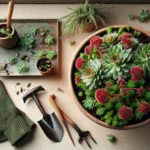Astonishing Features of Sedum Morganianum
Gazing upon the Sedum Morganianum, one can’t help but be mesmerized by its unique cascading splendor. Commonly known as the “Donkey Tail” or “Burro’s Tail,” this succulent is a show-stopper with its trailing stems that delightfully spill over the edges of pots and hanging baskets. Each stem is densely packed with fleshy, teardrop-shaped leaves, creating a lush, flowing effect that’s both texturally and visually captivating.
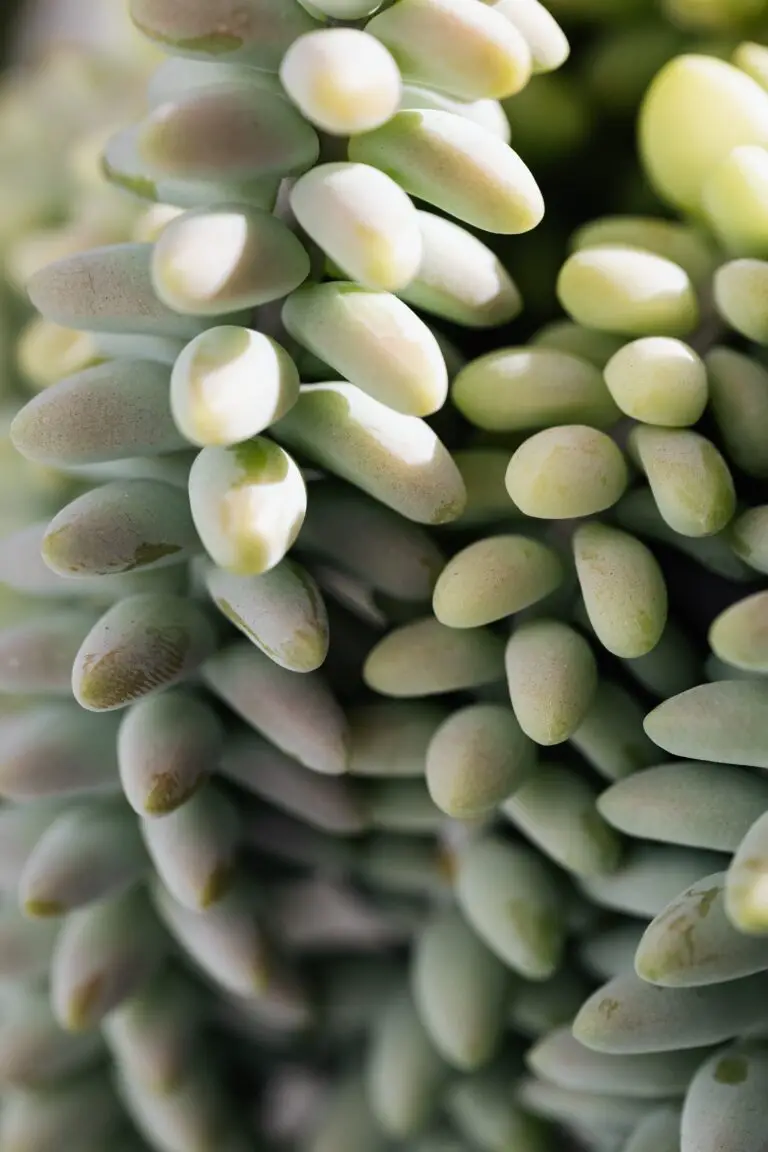
The appeal of Sedum Morganianum isn’t just limited to its aesthetics. Gardeners value this succulent for its low maintenance and drought-resistant qualities, making it a resilient choice for various gardening contexts. In urban environments, where green space is at a premium, the Sedum Morganianum thrives as a vertical green accent on balconies, bringing a touch of nature’s grace to concrete jungles.
Envision a sun-drenched Mediterranean courtyard, where the Sedum Morganianum adorns ancient stone walls with its soft, green waterfalls. Or imagine this succulent as part of a larger succulent tapestry, contributing to the rich diversity of forms and textures. Its enduring charm lies in its undemanding nature and its ability to bring life to both minimalist and lavish gardens with equal flair.
For those who seek a touch of the exotic in their plant collections, Sedum Morganianum doesn’t disappoint. Whether used as an elegant solo act in a suspended planter or as part of an intricate succulent arrangement, this species stands out with grace. Its serene beauty is a reminder of nature’s simplicity and the effortless splendor it can bring to our living spaces.
Optimal Growth Conditions
Welcome to the world of Sedum Morganianum, affectionately known as the “Donkey’s Tail,” where mastering a few fundamental growth conditions can turn your thumb as green as the vibrant leaves of this succulent wonder. Let’s dive right in and discover how to create the perfect haven for your cascading beauty!
Luscious Soil: The Foundation of Vitality
Imagine you’re a gourmet chef preparing a five-star meal. The ingredients you choose are key, right? The same goes for the soil mix for your Sedum Morganianum. Combining organic potting soil with mineral-rich materials like coarse sand or perlite is like curating a Michelin-starred menu for your plant. This succulent craves excellent drainage to avoid the dreaded soggy bottom syndrome, which can lead to root rot. For a stellar soil mix recipe, this guide on crafting your own succulent soil becomes your go-to resource!
Let There Be Light: Illuminating Life
The Donkey’s Tail soaks up the sun like a tourist on a tropical vacation. Bright, indirect sunlight is its preferred SPF, ensuring its leaves maintain that plump, juicy look while warding off sunburn. A spot near a sunny window where the rays are filtered through a sheer curtain could be your plant’s personal paradise.
Thermometer Tales: Balancing the Extremes
When it comes to temperature, think of a spring day in the Mediterranean – that’s the kind of climate Sedum Morganianum aspires to. Ranging from 65°F to 75°F (18°C to 24°C), these conditions provide the perfect balance between cozy warmth and refreshing coolness. This succulent doesn’t take too kindly to frost, so ensure it’s brought indoors when the outdoor temperature starts to dip!
Humidity: The Invisible Embrace
Despite being a succulent, the Sedum Morganianum doesn’t want to live in the Sahara. Moderate humidity is the invisible embrace it longs for. If your home resembles the dryness of winter air, consider a pebble tray or a humidifier to add that whisper of moisture in the air. But remember, like a Goldilocks tale, it’s all about that ‘just right’ amount.
To wrap your mind better around care tips for your Sedum Morganianum, I’ve found a video that captures the essence of nurturing our delicate Donkey’s Tail. Click play and let’s watch our verdant friend thrive!
Watering Wisdom: Hydrating Your Sedum Right
When it comes to quenching the thirst of your Sedum Morganianum, also lovingly known as the Donkey’s Tail, there’s a fine line between too little and a waterlogged disaster! So, let’s dive into the hydrating habits that will keep your cascading beauty flourishing.
Imagine it’s a scorching summer day. You’ve just grabbed an ice-cold drink, and ah, that first sip is pure bliss! Your Sedum cherishes moisture just like you do on a hot day, but with a twist. These succulent beauties store water in their leaves, acting like a built-in water bottle. So be the excellent bartender—serve up a drink when the soil feels dry, not because the calendar says so.
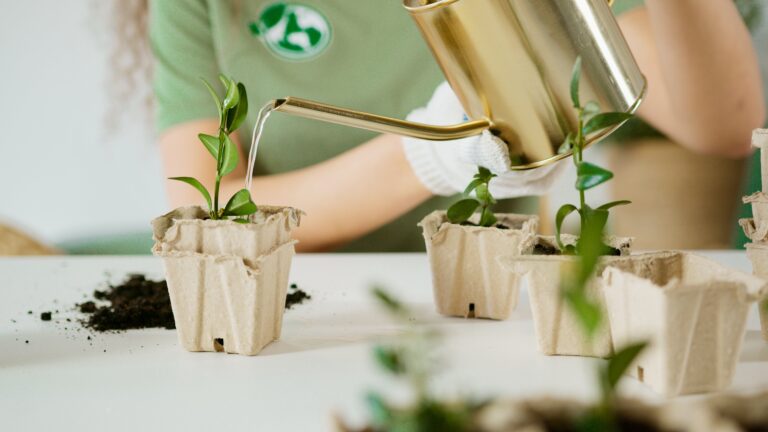
But how often, you ask? Picture this: a plant parent eagerly clutching a watering can daily. If you’re nodding along, put that can down! Your burro’s buddy prefers a soak-and-dry method. It’s like binge-watching your favorite show and then patiently waiting for the next season. Translation: Water thoroughly, then give it a break, letting the soil dry out completely between waterings.
Here’s where it gets dicey—overwatering is your Sedum’s nemesis, leading to a mushy mess and the dreaded root rot. Imagine wrapping your sedum in a wet blanket—uncomfortable, right? Instead, aim for that perfect sip. Enough to satisfy but not drench, ensuring those roots stay snug, dry, and healthy. Need a more tangible cue? The leaves will pucker slightly when they’re thirsty—nature’s subtle nudge to grab that watering can.
Want a pro tip? Check out this handy guide for keeping your Sedum Morganianum in tip-top shape.
The takeaway? Water wisely. Your benevolent care and attention to detail make all the difference in cultivating a verdant and vivacious Sedum Morganianum. Quench its thirst with expertise and watch those lush, trailing vines become an enviable and splendid display of cascading beauty.
Feeding Your Sedum: Fertilization Fundamentals
When it comes to nurturing a thriving hanging haven of Sedum morganianum, also known as the “Donkey Tail” or “Burro’s Tail,” understanding the what, when, and how of fertilization is key. Imagine your sedum as a thriving acrobat, swinging from the pots in your garden, but just like any performer, it needs the right nutrition to keep the show spectacular!
First things first, selecting the right type of fertilizer is crucial. Think tailored suit versus off-the-rack—your sedum deserves a custom-fit meal. You’ll want to grab a balanced, water-soluble fertilizer, preferably with a 10-10-10 or 20-20-20 ratio of nitrogen, phosphorus, and potassium. These are the three musketeers of nutrients that will keep your succulent’s foliage firm and the stems robust, ready for that awe-inspiring cascade effect.
Now, don’t just douse your dangling darling in a deluge of nutrients. The feeding schedule for Sedum morganianum should coincide with its growth cycle. That means fertilizing every two weeks during the spring and summer, its main growing season, when the sun is shining and growth is most vigorous. Contrastingly, in the fall and winter, your sedum takes a well-deserved rest, and so should your fertilization efforts.
Let’s not forget about the real-life application of these fertilization fundamentals. Picture your friend’s envy when your sedum boasts plump, jade-green leaves, thanks to your diligent nutrient applications. To see this magic in action, check out this handy video:
Remember, more is not always merrier when feeding your Sedum morganianum. Overzealous fertilizing can cause rapid, weak growth, leaving your succulent susceptible to pests—akin to overfeeding a pet, which no loving gardener wants to do. Treat it to just the right amount of fertilizer, and you’ll be rewarded with a luxuriant, healthy growth that’s the envy of any succulent conductor.
For additional insights into succulent care, check out The Ultimate Guide to Succulent Care and grace your green thumb with knowledge to nurture not only your Sedum morganianum but all your fleshy-leafed friends.
Propagating Sedum Morganianum
Ready to expand your succulent collection? The Sedum Morganianum, affectionately known as the “Donkey Tail,” is a spectacular cascade of lush, trailing beauty, and propagating it is a breeze! We will guide you through the process of propagation from leaf cuttings or stem segments, ensuring your new plants thrive.
Gathering Your Cuttings
First things first—gently select a few plump leaves or a healthy stem segment. Be sure to make a clean snip using sterilized scissors or a knife to avoid any infection. This little step is crucial for a successful propagation journey.

Rooting Your Sedum Morganianum
Lay the leaves or stem segments on a dry surface for a few days to allow the cut ends to callous over—it’s like putting a protective seal on a fresh wound. Next, prepare a shallow container with well-draining succulent soil, perhaps mixed with a dash of sand or perlite, and gently press the cuttings just on top. The magic starts here!
While patience is key, providing your cuttings with the right environment will speed up the process. Place them in a bright spot with indirect sunlight, ensuring they aren’t scorched by the intense midday sun. Light watering is your friend here, as too much moisture might spell doom for the fledgling roots. Watch as tiny pink roots emerge—a hint that you’re on the path to success!
Live by the axiom “less is more” when nurturing your new Sedum Morganianum babies. Just a sprinkle of water when the soil feels dry is enough! Too much attention can be smothering; they thrive with a little room to breathe and grow.
Caring for Newly Rooted Cuttings
Once you see a respectable root system and the first signs of new growth, which could take several weeks, it’s time to celebrate! Your propagation prowess is paying off. Give these new plants their own homes in pots that show off their cascading beauty, and let them grow into mature specimens that might just become the envy of any succulent enthusiast.
The Sedum Morganianum is more than just a plant—it’s a testament to the joy of gardening and the rewards of patience. So go ahead, get propagating, and bask in the splendor of these cascading wonders!
Landscaping with Burro’s Tail: Design Ideas
Sedum morganianum, or the charmingly nicknamed “Burro’s Tail,” is not just your average succulent. The trailing, lush green tendrils cascade beautifully, making it an irresistible choice for a dramatic landscaping statement. This succulent’s versatility is vast, and its low-maintenance nature makes it an excellent pick for gardeners looking to add a splash of greenery that practically takes care of itself.
Imagine a serene rock garden where the green waterfall of Burro’s Tail flows between stones, providing a stunning contrast with its soft, pendulous stems. Each frond is populated with plump, jade-like leaves, sculpting a visual feast that’s both grounding and whimsical. Paired with pale-hued pebbles or against the stark outline of dark slate, Sedum morganianum catches the eye and holds it in a verdant embrace.
Another scene-stealer is the integration of this succulent into terrariums. Enclosed in glass, the Burro’s Tail becomes a living work of art, embodying lushness in miniature form. The trailing quality of its stems allows for creative display as they spill out from open containers or charmingly press against the transparent boundaries of their glassy enclosure.
For those who favor the indoors, think of the dramatic flair Sedum morganianum brings to interior spaces. Hung high in sunny nooks or perched atop bookshelves, the green tendrils cascade downwards, inviting nature into the home with their effortless waterfall-like form. They make a bold statement while harmonizing with both modern and rustic decors, truly a versatile choice for greenery lovers.
In communal spaces such as patios or social gathering spots, Burro’s Tail can create a sense of green continuity when used as a living curtain or divider. Structured yet informal, these natural screens speak of an easy-going elegance and bring a refreshing organic touch to any entertainment area.
Lastly, consider the sensory garden, where Sedum morganianum whispers of tactile wonders. Its delicate leaves beg to be brushed by the wanderer’s fingertips, adding an interactive facet to the environment. The plant’s responsiveness to touch—weaving as it will—engages visitors in a silent dialogue. It encourages a lingering gaze, completing the sensory journey with its cascading beauty.
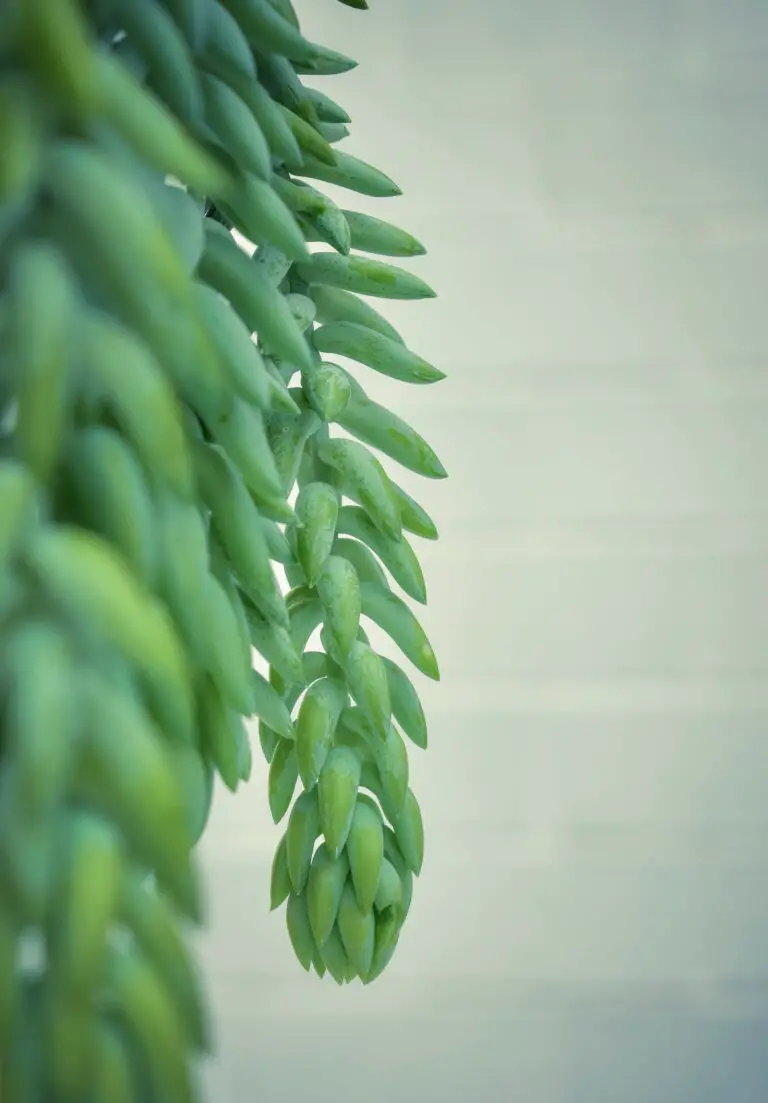
Pest Control: Protecting Your Succulent
The whimsical tendrils of Sedum Morganianum, known as the ‘Donkey Tail’ plant, bring an unparalleled verdant splendor to any space. However, the lush cascade it forms, so pleasing to our eyes, can also be a siren’s call to an array of common pests. Apprehending these tiny invaders is the first step to ensuring your cascading beauty remains just that—beautiful.
Let’s introduce some of the usual culprits: aphids—those pesky, sap-sucking insects that cluster like little criminals on new growth and leaves, leaving behind a sticky residue known as honeydew. Mealybugs, resembling tiny cotton dwellers, which carve out comfy homes in the crevices of your plant. Then there are spider mites, almost invisible marauders, weaving fine, silken webs between the fleshy leaves, as they feast.
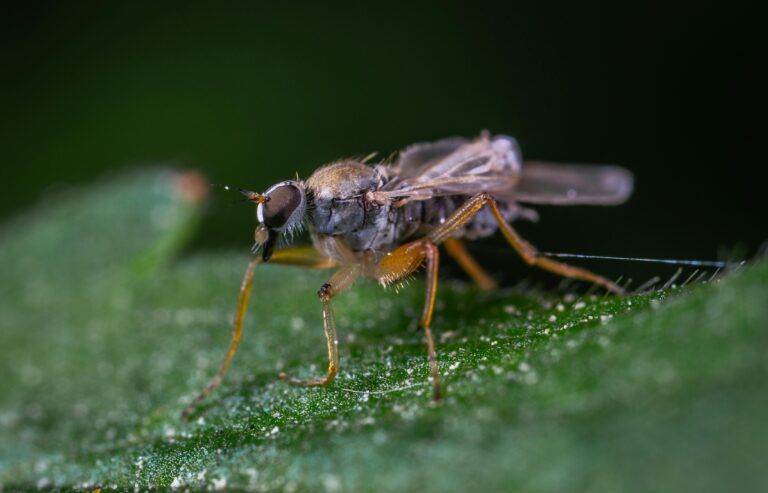
In combatting these invaders, eco-friendliness is our arsenal’s cornerstone. Starting with a straightforward blast from your garden hose can dislodge the less tenacious pests. For those clinging on, insecticidal soaps come to the rescue—effective yet gentle on both plants and the environment. Neem oil, an organic cultivator’s ally, can be used as a preventive measure or an insecticide when sprayed on affected areas.
Imagine this: the perfect sunny spot in your home, where your Sedum Morganianum sits in lush splendor, unmolested by the vicissitudes of pestilence, because you’ve become a connoisseur of ecological pest control. By keeping a vigilant eye for signs of pests and taking swift, earth-friendly action, you can cultivate health and happiness for your seductive succulent.
Eco-Friendly Measures in Action
One of our green-thumbed friends once encountered a severe aphid infestation on their cherished Sedum Morganianum. Rather than reaching for harsh chemicals, they used a homemade spray consisting of water, a few drops of dish soap, and neem oil. After several applications, their plant was thriving once again, showcasing the power of natural pest control—and patience!
Another enthusiast found spider mites orchestrating their tiny revolts beneath the leaves. Their solution? Increasing humidity around the plant—spider mites detest moisture. By frequently misting the plant and maintaining a regular schedule for neem oil applications, they sent the mites scampering for drier realms. In both scenarios, environmentally conscious solutions proved effective and gentle on their cherished Sedum Morganianum.
Endeavor to emulate these success stories in your own garden. Survey your Sedum Morganianum regularly for uninvited guests, and when you spot them, reach for those eco-friendly remedies. Sustainable pest control practices not only protect your succulent sanctuary but also contribute to the broader health of our precious planet.
Troubleshooting Common Issues
As captivating as the Sedum Morganianum is with its lush, trailing foliage, it is not without its fair share of drama. Even the most attentive plant parents can encounter setbacks. Not to worry though – roll up your sleeves, and let’s dive into the common mishaps faced by these succulent beauties and unearthen sage advice to turn the tide.
Leaf Drop: When Touch Triggers Tumble
The cascading leaves of the Sedum Morganianum, delicate as morning dew, can sometimes drop at the slightest nudge. Imagine you’re admiring your plant, a slight graze, and there goes a leaf – plop! It’s a common spectacle that can be curtailed by understanding its cause. Too much water, too little light, or an abrupt change in environment might be the culprits. A steady watering regimen and a stable, well-lit home can often set things straight.
Discoloration: A Colorful Conundrum
Yellow, brown, or pale leaves? Don’t fret just yet! Your verdant companion could be sending signals of distress. Overwatering often takes the blame, turning robust green into hues of despair. On the flipside, sunburn may leave leaves looking like they’ve had too much fun in the sun. The solution lies in balance – moderate watering and strategic sunlight exposure will keep your Sedum Morganianum vibrant and happy.
Rot: The Damp Death Sentence
One day your Sedum Morganianum is the epitome of health; the next, it’s succumbing to a case of the rots. Don’t declare it a goner just yet! Overwatering is often the arch-nemesis, leading to a soggy demise. Scaling back on the H2O and ensuring proper drainage can bring your plant back from the brink. It’s also wise to inspect and trim away any affected areas to stop the spread in its tracks.
Remember, your Sedum Morganianum is not just a plant; it’s a living, breathing entity that needs your understanding and care. Like a master detective, you can discern its needs and nurse it back to lushness. Keep an eye out, listen to what it’s telling you, and you might just become the Sherlock Holmes of indoor gardening.

Seasonal Care Tips: From Spring to Winter
As garden aficionados know, seasonal changes bring new opportunities for cultivating growth, and the Sedum Morganianum is no exception. From the awakening buds of spring to the dormant quiet of winter, each season bestows upon this cascading beauty its own set of care instructions. Let’s untangle the seasonal secrets of Sedum Morganianum care—for those ready to see their green tendrils thrive year-round.
Embracing Spring’s Awakening
With spring’s arrival, the Sedum Morganianum stirs from its rest. Imagine the delicate tendrils perking up towards the warming sunlight. This is your cue to increase watering gradually, mimicking nature’s gentle nudge. Fertilize lightly with a balanced, slow-release formula to kickstart growth—like a gentle whisper encouraging the plant to unfurl.

Summer’s Vibrant Routines
During the summer, Sedum Morganianum basks in the sun’s glory. The key here is consistency—steady watering as the temperatures rise, ensuring the soil is like a moist summer morning, not a midday drought. It’s the season of growth, so consider a half-strength water-soluble feed bi-weekly, as if you’re serving a refreshing drink on a hot afternoon.
Autumn Adjustments
As leaves fall and the air cools, cut back on watering and feeding. Picture the plant, like a woodland creature, preparing for a slower pace of life. Let the soil dry a bit more between watering, to strengthen the plant against the cold to come. Pruning isn’t necessary, but removing any damaged leaves can be like dusting off a cherished book before it’s shelved for winter.
Winter’s Gentle Dormancy
Winter whispers a time of rest. Sedum Morganianum’s growth wanes, and overwatering is the lurking frostbite ready to nip at its roots. Water sparingly, just enough to prevent desiccation—like a warm scarf lightly draped, not stifling. For those brave enough to be outdoors, provide a shelter to guard against frost—a simple kindness from the harsh elements.
Remember, life’s patterns are echoed in the care of Sedum Morganianum—seasonal rhythms, whispers of change, the warmth of sunlight, and the coolness of shade. Care for it as you would for any living being experiencing the ebb and flow of time, and watch as its cascading splendor mirrors the passing of seasons.
Frequently Asked Questions
Ever wondered why your Sedum Morganianum, also lovingly dubbed the ‘Donkey Tail,’ seems to dance joyfully from its hanging basket? Or why those plump, jade-like tendrils evoke the serene beauty of a verdant waterfall? You’re not alone! Let’s traverse the riveting world of the Sedum Morganianum through a series of questions that plant enthusiasts like you commonly ponder.
What Makes Sedum Morganianum Ideal for Hanging Baskets?
Imagine a cascade of emerald vines spilling over the edge of your balcony basket, each delicate leaf bursting with life. The Sedum Morganianum is the undisputed star of vertical gardening. Its trailing growth habit naturally seeks the grace of gravity, making it perfect for elevated displays where it can whimsically drape downwards, showcasing its full splendor.
How Often Should I Water My ‘Donkey Tail’?
Think of a desert after a rare rainfall, where succulents greedily gulp up every drop: That’s when your Sedum Morganianum wants a drink. Thriving on neglect, water it sparingly—typically once every two weeks, decreasing in winter. Always ensure the soil dries out completely before the next watering to mimic its native rocky outcrops.
Is Sedum Morganianum Fast Growing?
Rapid growth isn’t just for beanstalks in fairy tales. In the right conditions—bright, indirect sunlight and warm temperatures—your Sedum Morganianum can add braids to its foliage at a captivating pace. It’s a spectacle to watch these succulent tendrils elongate, seeking sunlight and room to breathe. Just don’t blink, or you might miss it!
Can I Propagate My ‘Donkey Tail’ from Cuttings?
A single dropped leaf can be the humble beginning of a new succulent saga. Lay it on well-draining soil and watch the magic happen. Propagation from stem cuttings? Even better! Snip a length, let it callous over for a day or two, and plant it to start a new cascading beauty. Share them with friends, and spread the Sedum love!
Why Are the Tips of My Sedum Morganianum Turning Pink?
Your plant is blushing with pleasure! Kidding aside, the rosy hue at the tips of your Sedum Morganianum is a sun-kissed badge of honor. It’s proof of just enough sunlight gracing its foliage, a charming bit of natural beauty highlighting the plant’s adaptability and resilience. These sunbaked tips are the plant’s version of a perfect tan.

Dealing with Pests: What Are the Common Culprits?
Rarely does Sedum Morganianum encounter villainous pests, but when it does, mealybugs, spider mites, and aphids are the usual suspects. Catch them red-handed by inspecting the undersides of leaves and deal with these uninvited guests using insecticidal soaps or neem oil. Prevention? That’s key! Keep your sedum healthy, and it’ll be less like a bug bed-and-breakfast.
How Can I Ensure My Sedum Morganianum Flourishes?
Summon the spirit of a seasoned gardener: Provide ample sunlight, a cozy pot with drainage fit for a king, and infrequent watering worthy of a desert dweller. Shield it from frost’s icy fingers and scorching midday sun alike. With these royal treatments, your Sedum Morganianum will thrive, enchanting onlookers for seasons to come.
Now, as your green fingers itch to tend to your succulent friend, remember these nuggets of wisdom. The Sedum Morganianum, like any plant, tells a story. Listen closely, and it’ll whisper the secrets of its cascading beauty right into your gardener’s heart.
